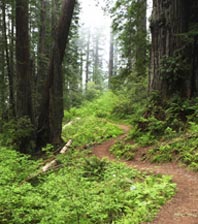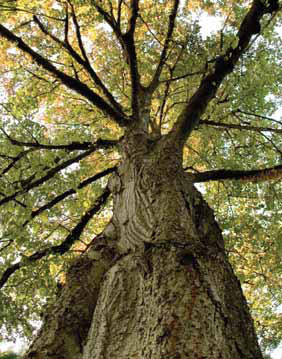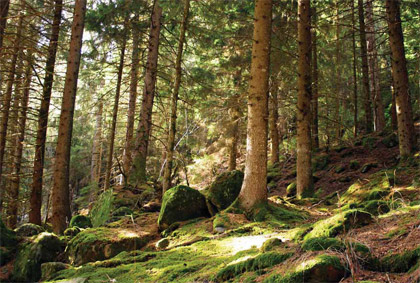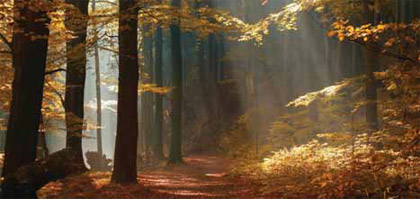America’s Forests: An Important First Step in Combating Climate Change
America’s forests are enchantingly beautiful and mysteriously engaging. They cast a spell over anyone who enters their kingdom by exerting a magical power unequaled in nature and by creating a presence so commanding that the rest of the natural world bows to it. No one who truly ventures into forests escapes their mesmerizing aura or captivating spell. American Indians have always known the true power of forests, as have a group of devoted, educated caretakers known as foresters.
The rest of us were largely unaware of their true power. We considered them beautiful but benign, awesome but without spirit. Humans were the powerful life-givers and life-takers, and forests existed to do our bidding – to build our cities and to provide our amenities – always at our beck and call with a clearly stated hierarchy – humans, the masters; forests, the servants.
But all that has changed. In fact, all that never was. It took global warming for many of us to understand that the reverse is true and always has been. Forests are the life-givers and the life-takers, the magical “beings” that transform nothing into something. Humans are just lucky enough to be tagging along for the ride. And the ride will stop sooner than we think if we don’t set our priorities straight.
“If you touch a forest, you touch everything,” says John C. Gordon, Pinchot Professor Emeritus of Forestry and Environmental Studies at the Yale School of Forestry and Environmental Studies. This expert points out that forests make the air breathable, provide more than half of America’s clean drinking water, cool lakes and streams for cold water fish, provide food and medicine, help regulate local and regional rainfall, increase arable land, create the world’s most renewable building material, provide an endless amount of fuel, maintain a loving home for the world’s animals and plants and bathe us daily in a scenic beauty that is beyond reproach.
And, as if humans didn’t already owe forests much, Americans are only now beginning to understand their indispensable role in global warming. According to the Pew Center on Global Climate Change, one-third of the United States is covered by forested lands – an indispensable natural resource that serves as a vital component in combating global climate change.

© iStockphoto.com/ericfoltz
Larry Wiseman, president of the American Forest Foundation (AFF), a non-profit organization that promotes education about and conservation of America’s forests, dedicates his time to their preservation. He believes that forests in the United States are an asset not only at home but also to the world at large. Unfortunately, the importance of forested land is not often understood by citizens and landowners. “I think people don’t understand the important stake forests have in healthy growing,” Wiseman reiterates. “Americans are disconnected in many ways from the landscape in which they live.”
This disconnect between landowner and land is fueled by urbanization and suburbanization of America. But this disconnect, in fact, is one that Americans and the world cannot afford, especially as global climate change worsens. After all, Wiseman explains, forests serve as one of the primary “carbon sinks” on earth. But, what exactly is a “carbon sink”?
Forests require carbon dioxide (CO2) for efficient growth. So, as trees age and grow larger, they are able to absorb more CO2 from the earth’s atmosphere. As a net benefit to society, carbon levels are reduced and impacts of global warming are curtailed. Wiseman explains that each tree can absorb up to one ton of CO2 every year of growth. Thus, forests become a “sink” for carbon – reducing CO2 levels from the atmosphere and containing them within the wood.
The Union of Concerned Scientists (UCS) explains in a current report, Recognizing Forests’ Role in Climate Change, “In the U.S., forests are currently net carbon ‘sinks’ sequestering more carbon than they emit. A key reason for this is that forests in the Northeast and elsewhere, cleared previously for agriculture, are now reestablishing on abandoned lands.” UCS findings also cite that forests could reduce carbon levels of “projected fossil fuel emissions through 2050” by 10-20 percent.
While forest growth is of the utmost importance, to be healthy it must be contained and managed to some extent, explains Chief Forester Bill Downes and his co-worker John Vitello, forester and senior specialist, Department of the Interior (DOI) Bureau of Indian Affairs (BIA). Downes and Vitello work with Indian tribes on more than 18 million acres of forested tribal lands, as well as with 56 million acres of Indian agricultural lands. BIA follows tribal practices of sustainable forestry management by utilizing forests for economic benefits, cultural development and daily survival. However, preserving forests and utilizing them as a benefit against climate change does not occur without a plan.
“I think one point most people don’t understand is that we can’t just walk away from forests. Nature isn’t just going to take care of them and make them into parks like people want. Because when you leave it up to nature, you’re going to get what nature is going to give you, which could be disease, insect infestation or catastrophic fire,” Downes said. “But we can mitigate all three through active management of forests.”
Vitello agrees and explains, “There’s been a lot of talk recently about using Indian forests as a model for other public landowners and maybe even for private landowners. Indians have traditional knowledge from centuries of management. And because they live on the land they manage, they have to live with the consequences of their management decisions. Therefore, they use that experience to temper everything they do.”

© iStockphoto.com/carrollphoto
For thousands of years, Vitello says, native peoples of the Americas, both North and South, lived off the land using forests to “benefit their lives while continuing to manage this precious resource for future generations. That’s the philosophy a lot of us forestry managers have: We want to see forests managed in a way that can benefit all future users of forests and use them for what we need them for.”
The U.S. Geological Survey (USGS) states that as climate change continues, drinking water supplies will be adversely impacted in both quantity and quality available. With this in mind, America’s forests, as the leading supplier of drinking water, must be managed sustainably. If forests are not safeguarded appropriately (i.e., allowed to grow without a synergistic relationship with mankind in both present and future), catastrophic results will occur. Vitello describes this delicate balance by delineating the possible outcomes as a result of both extremes: If not managed enough, forests will continue to overgrow and will create a perfect environment for fire and destructive disease to run rampant, both of which pose a serious threat to the very existence of America’s forests. Conversely, if trees are arbitrarily and massively clear-cut with no set plan for forest sustainability, the loss of trees would result in a water, food and habitat loss for all life, not to mention land erosion, drought and possible mudslides, to name a few consequences. Thus, a balanced, sustainable approach to conservation is necessary for mankind, for forests and for forest inhabitants.
Furthermore, in American cities often devoid of forested land, temperatures have a tendency to rise exponentially. With global warming expected to generate higher temperatures throughout the country, forests can have a cooling ability through “transpiration,” Vitello says. This process, similar to the perspiration of humans, cools not only the trees but the humans who live near them. Aside from being climate change agents, water management tools, cooling devices and carbon sinks, forests have the potential to wean fossil-fuel dependent nations, such as the United States, off their long-standing addiction to archaic and polluting forms of energy. Forests, if utilized properly, house acres upon acres of an untapped energy source which, if utilized, would reduce CO2 levels even more.
“Trees are part of the short-term carbon cycle,” Vitello explains. As part of this phenomenon trees in America’s forests can capture CO2 for 100-300 years or beyond, depending upon the longevity of a tree species. “Stored carbon is released when balance is critical to gain leaves come down, trees die naturally or they are harvested. A tree will eventually either decay and release carbon, release the carbon through combustion or be used in a product that stores the carbon longer,” Vitello continues. All of this can be referred to as the “short-term carbon cycle,” which, unlike the “long-term carbon cycle,” provides no human-caused increases in CO2 emissions because the tree was going to release this CO2 in the short-term anyway.
Instead of focusing on the “short-term carbon cycle,” Americans have focused on the “long-term carbon cycle” by utilizing fossil fuels that would never get released by nature in the short-term, and by adding CO2 to the atmosphere in an unnatural, cumulative and unprecedented fashion. Vitello reiterates, “What we’ve been doing as a culture is focusing on long-term carbon reserves (specifically, fossil fuels) and releasing that into the atmosphere.”
As a result of increased CO2 emissions, the impacts of global climate change have been both exponentially expedited and exponentially worsened in a manner nature never intended. Vitello and Downes, though, believe that an answer to America’s addiction to coal and oil can be curtailed through innovation by using biomass for energy production.

© iStockphoto.com/gloadventers
According to Vitello, “biomass” (wood waste that includes limbs, roots, leaves, etc.) can be used to create heat, electricity, liquid fuels, (cellulosic) ethanol and diesel. “All of that holds promise because it’s still using the short-term carbon cycle – carbon that is going to be lost in the short-term anyway. It’s called being ‘carbon neutral,’” he explains
Downes notes that more than 100 billion tons of renewable energy resources (in the form of carbon biomass) is created and not utilized every year; all 100 billion tons are produced in America alone. And, according to Vitello, the United States is limited only by its lack of desire for innovation. “We need a national will to make it happen,” Vitello says. “Why not create a system in which we are energy-independent, using whatever waste material that we have. Why not let that be the vision?”
The conservation and protection of the world’s forested lands is Dr. Gordon’s continued avocation. After a lifetime of study and devotion, he understands the forests probably as well as anyone else on earth, which is why the retired Yale professor is known as one of the world’s foremost forestry experts. Gordon concurs with Downes and Vitello, yet he adds that trees (through providing shade) also indirectly lessen the results of global warming. While trees increase shade and cooling, they also allow Americans to consume less energy through air-conditioning, which relies on electricity – often fueled by coal-fired power plants that are the main source of CO2 with respect to the human-induced impacts of climate change.
Gordon also explains that trees have the ability to not only curtail global warming but also to exemplify global climate change trends and impacts. This reputable source says that through a complex process of matching patterns of tree rings in existing trees to those in past trees, scientists are able to better understand climate change by looking for “indicators on the amount of change.”
While many activist groups and vocal organizations like to criticize the United States for its forestry practices, Gordon, who has consulted extensively on forests throughout the world, thinks that the United States serves as an example to the rest of the world for proper and healthy forestation. “On the whole,” Gordon says, “The United States has done pretty well.” In fact, Gordon knows that the United States has created more wood per year than it uses – a promising sign for both sustainable development and for global climate change.
When presented with a strikingly frightening hypothetical of a world with no more viable forests, Gordon said that the impacts would be devastating, but they would first be felt locally, as opposed to nationally or internationally. Without good forest management or with uncontrollable forest fires, Gordon said that local climates will change; wind speeds will increase; warmer temperatures will occur; water will rapidly run off land and cause soil erosion, landslides and, inevitably, more CO2 released into the atmosphere.

© iStockphoto.com/AVTG
As a proposal to thwart off such chaos and devastation, Gordon explained that three imperative realizations about forests must be understood:
1. “We ought to keep the forests we have as forests,” Gordon explained.
As urbanization of the American landscape grows, forests are cut down for the purpose of expansion and development – an economic move that, in the long run, is not worth the potential devastation that could occur. Current trends hold out promise that America’s forests will remain forests because 2/3 are privately owned with 55-60 percent overseen by private landowners instead of private corporations, Gordon said.
2. “Forests are important to every aspect of our current existence,” Gordon said. “If you touch the forest, you touch everything.”
Forests impact not only the air that we breathe but significantly lessen the effects of climate change. If America’s forests are abused, water supplies and safety will be at the top of the list of consequences. But, just as a lack of forests will have negative repercussions, well-managed and conserved forested lands will lead to the betterment of mankind by reducing CO2 and ambient temperatures while providing natural supplies of drinking water in great quantities and with increased quality. In fact, a properly managed forest allows for the perfect balance of healthy tree and vegetation growth with water yield. In addition, forests shade lakes and streams for cold water fish allowing them to live in waterways that would, otherwise, be too warm because of the sunlight. This interdependency provides the key to nature’s synchronicity.
3. “Think about forests and what they can do,” Gordon said. “Understand forests better.”
This point is incredibly important – especially because America’s huge resources of forested land are owned largely by private citizens. These landowners must assume the moral and economic obligation to protect one of America’s greatest natural resources and accomplish this goal in a fact-focused, educated manner with sustainability at the forefront of every decision. As a new generation comes forward and is plagued with the global climate crisis and economic pressures they have inherited, it will become increasingly critical that they continue preservation and not allow coveted land treasures to be decimated by urban development – at any price.
As the world faces a global epidemic of international climate change, it’s ironic that the same land that hundreds of millions of Americans flock to every year for beautiful outdoor experiences is such a fundamental, working life force that simultaneously manages to provide so many life-sustaining services. Who would have thought that within those majestic redwoods, awe-inspiring spruce trees and enchanting holiday pine trees would exist such a complex bioengineered system capable of engaging, protecting and giving life.
Hanging on the wall of Downes’ BIA office in Washington, D.C., is a picture with a framed quotation and motto that seems to be more pertinent today than ever before: “Managing our lands… Reshaping our future.” Forest management, education and conservation may, indeed, be the keystones that can allow us a future to shape because a life without forests is unthinkable and unlivable.





























